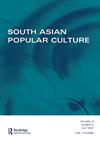The provincial Flâneuse: Reimagining provincial space and narratives of womanhood in Bollywood
IF 0.3
0 ASIAN STUDIES
引用次数: 0
Abstract
ABSTRACT This essay uses the interpretive lens of the flâneuse to read Rumi, the protagonist of Anurag Kashyap’s 2018 film Manmarziyaan, as an emergent figure who exemplifies provincial confidence and aspirations through specific notions of autonomy in the public space. At the core of this and similar portrayals, I argue, is a changing relationship between gender formations and provincial space, accessed not only in movement or ambulation but in a narrative of space and modernity not written by hegemonic or dominant forces. I read Rumi as a provincial flâneuse because she rewrites the provincial space that marginalizes her, and she does this not with income and ambition, or with brute power and violence, but with pleasure, movement, and affect. Her remaking of space is influenced by capital and the rhetoric of prostitution (the two contexts in which the flâneuse was historically imagined) but it is determined by neither. Rumi’s flânerie is, then, her struggle to weave a modern self from the disparate strands of provinciality, urbanity, and the uneven imbrications of the two. Her incomplete cooptation by both the provincial and the urban ensures ongoing dialogue between the two spaces, evident in the film’s use of hip hop, and tropes like the failure to elope to the city, and the terrace.省级Flâneuse:重塑宝莱坞的省级空间和女性叙事
摘要本文运用法语的阐释镜头,解读了阿努拉·卡什亚普2018年电影《Manmarziyaan》中的主人公鲁米,他是一个通过公共空间自治的具体概念来体现省级信心和愿望的新兴人物。我认为,这一刻画和类似刻画的核心是性别构成与地域空间之间不断变化的关系,这种关系不仅在运动或移动中得以触及,而且在非霸权或主导力量所写的空间和现代性叙事中得以触及。我把鲁米读成一个省级学者,因为她改写了将她边缘化的省级空间,她这样做不是出于收入和野心,也不是出于暴力和暴力,而是出于快乐、运动和情感。她对空间的重塑受到资本和卖淫修辞的影响(这两种背景是历史上想象的),但两者都不决定。因此,鲁米的小说是她从地域性、都市性和两者不均匀的重叠中编织现代自我的斗争。她在省级和城市之间的不完全合作确保了两个空间之间的持续对话,这在电影中对嘻哈的使用以及未能私奔到城市和露台等比喻中表现得很明显。
本文章由计算机程序翻译,如有差异,请以英文原文为准。
求助全文
约1分钟内获得全文
求助全文
来源期刊

South Asian Popular Culture
Arts and Humanities-Visual Arts and Performing Arts
CiteScore
1.00
自引率
0.00%
发文量
29
 求助内容:
求助内容: 应助结果提醒方式:
应助结果提醒方式:


